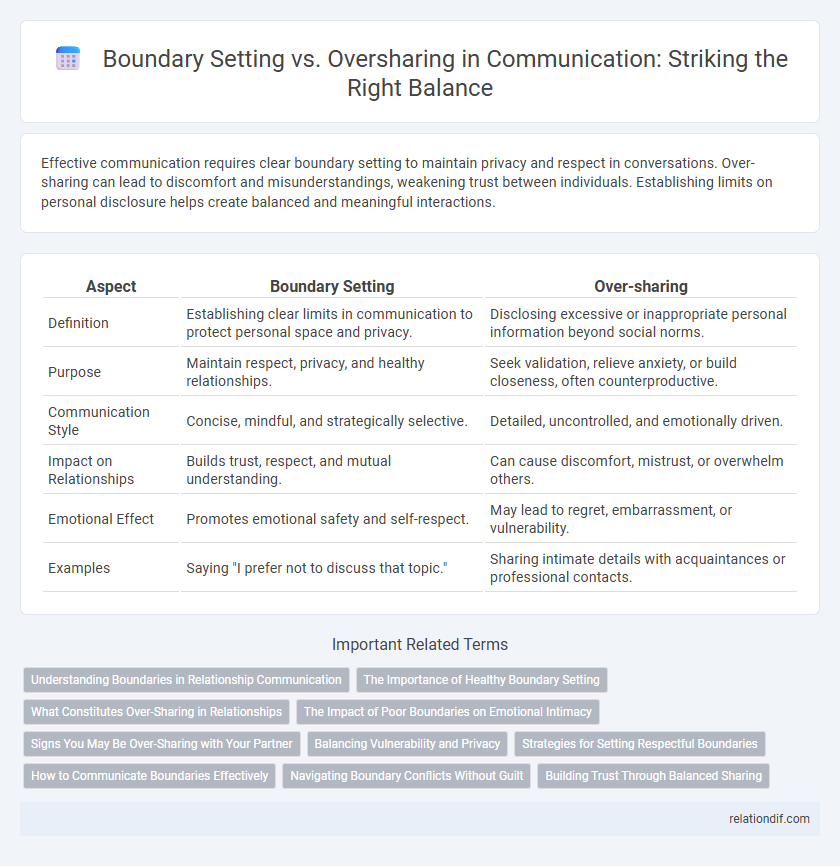Effective communication requires clear boundary setting to maintain privacy and respect in conversations. Over-sharing can lead to discomfort and misunderstandings, weakening trust between individuals. Establishing limits on personal disclosure helps create balanced and meaningful interactions.
Table of Comparison
| Aspect | Boundary Setting | Over-sharing |
|---|---|---|
| Definition | Establishing clear limits in communication to protect personal space and privacy. | Disclosing excessive or inappropriate personal information beyond social norms. |
| Purpose | Maintain respect, privacy, and healthy relationships. | Seek validation, relieve anxiety, or build closeness, often counterproductive. |
| Communication Style | Concise, mindful, and strategically selective. | Detailed, uncontrolled, and emotionally driven. |
| Impact on Relationships | Builds trust, respect, and mutual understanding. | Can cause discomfort, mistrust, or overwhelm others. |
| Emotional Effect | Promotes emotional safety and self-respect. | May lead to regret, embarrassment, or vulnerability. |
| Examples | Saying "I prefer not to discuss that topic." | Sharing intimate details with acquaintances or professional contacts. |
Understanding Boundaries in Relationship Communication
Establishing clear boundaries in relationship communication enhances mutual respect and prevents misunderstandings. Over-sharing personal information can lead to discomfort and erosion of trust, highlighting the importance of discerning what to share and when. Understanding boundaries enables partners to maintain emotional safety and foster deeper, more meaningful connections.
The Importance of Healthy Boundary Setting
Healthy boundary setting in communication fosters mutual respect and emotional safety, preventing misunderstandings and resentment. It empowers individuals to express their needs clearly while protecting their privacy and mental well-being. Maintaining these boundaries reduces the risk of over-sharing, ensuring interactions remain balanced and constructive.
What Constitutes Over-Sharing in Relationships
Over-sharing in relationships occurs when personal information is disclosed excessively or inappropriately, overwhelming the other person and disrupting emotional balance. It often involves revealing intimate details too soon, ignoring social cues, or failing to consider the context and boundaries of the relationship. Maintaining clear boundaries helps ensure communication remains respectful, fosters trust, and protects emotional well-being for both parties.
The Impact of Poor Boundaries on Emotional Intimacy
Poor boundaries in communication lead to emotional exhaustion and diminished trust, hindering genuine emotional intimacy between individuals. Over-sharing personal information prematurely can create discomfort and vulnerability, reducing the depth of meaningful connections. Effective boundary setting fosters mutual respect and secure emotional exchanges, strengthening relational bonds.
Signs You May Be Over-Sharing with Your Partner
Constantly divulging personal details without gauging your partner's comfort level can strain the relationship and hinder emotional balance. Oversharing often manifests in extended monologues, revealing past traumas prematurely, or expecting immediate validation, which may overwhelm your partner. Recognizing these signs allows for healthier boundary setting, fostering mutual respect and deeper connection.
Balancing Vulnerability and Privacy
Balancing vulnerability and privacy in communication requires establishing clear boundaries that protect personal information while fostering authentic connections. Effective boundary setting prevents over-sharing, which can lead to discomfort or exploitation of trust. Prioritizing respectful disclosure ensures that individuals maintain emotional safety while building meaningful relationships.
Strategies for Setting Respectful Boundaries
Effective boundary setting in communication involves clearly expressing personal limits while maintaining respect for others' feelings and perspectives. Strategies include using "I" statements to articulate needs without assigning blame and establishing consistent rules for sharing information to avoid over-sharing. Practicing active listening and pausing before responding helps reinforce boundaries and ensures conversations remain respectful and balanced.
How to Communicate Boundaries Effectively
Communicating boundaries effectively requires clear, assertive language that specifies your limits without ambiguity, ensuring the message is respectful and firm. Using "I" statements helps express personal needs and feelings while minimizing defensiveness, such as saying, "I need time to focus on work and prefer not to be disturbed during these hours." Consistency in enforcing boundaries reinforces their importance and reduces the risk of over-sharing, maintaining healthy communication and personal space.
Navigating Boundary Conflicts Without Guilt
Establishing clear communication boundaries prevents conflicts and supports emotional well-being, ensuring personal limits are respected without guilt. Over-sharing can blur these boundaries, leading to misunderstandings and strained relationships, which makes discerning appropriate self-disclosure essential. Effective boundary setting involves assertive communication and self-awareness, enabling individuals to maintain trust and mutual respect while protecting their mental health.
Building Trust Through Balanced Sharing
Establishing clear boundaries in communication prevents over-sharing, which can erode trust and create discomfort in relationships. Balanced sharing fosters openness while respecting personal limits, enhancing mutual understanding and reliability. Effective boundary setting signals respect for oneself and others, laying a foundation for consistent and trustworthy interactions.
Boundary setting vs Over-sharing Infographic

 relationdif.com
relationdif.com